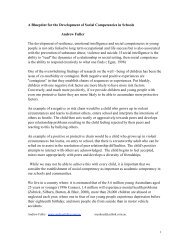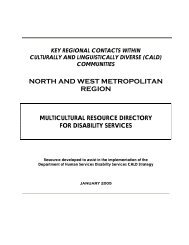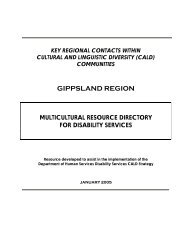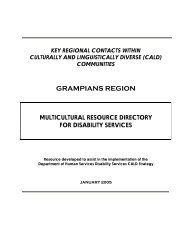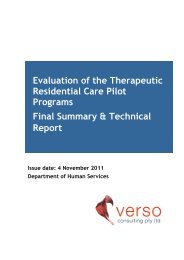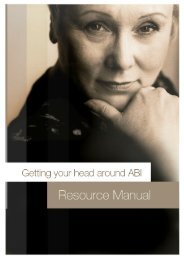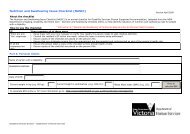Positive Behaviour Support - Department of Human Services - Vic ...
Positive Behaviour Support - Department of Human Services - Vic ...
Positive Behaviour Support - Department of Human Services - Vic ...
Create successful ePaper yourself
Turn your PDF publications into a flip-book with our unique Google optimized e-Paper software.
82 <strong>Positive</strong> behaviour support: Getting it right from the start - Facilitators reference manual<br />
PowerPoint 113<br />
PowerPoint 114<br />
*<br />
*<br />
As mentioned earlier, restrictive intervention refers to any intervention that is used to restrict the<br />
rights or freedom <strong>of</strong> movement <strong>of</strong> a person with a disability and includes:<br />
• seclusion; e.g. a room with a locked door/area and windows that the person cannot open<br />
from the inside<br />
• mechanical restraint; e.g. a device used to prevent, restrict or subdue a person’s movement<br />
• chemical restraint; e.g. medications used for the primary purpose <strong>of</strong> behavioural control<br />
People with a disability who show behaviours <strong>of</strong> concern and are subject to restrictive<br />
intervention must have a behaviour support plan that is reviewed and submitted to the senior<br />
practitioner at intervals not more than 12 months.<br />
Two functions <strong>of</strong> immediate response strategies<br />
1. To de-escalate a potential episode <strong>of</strong> the behaviour and manage serious episodes <strong>of</strong> the<br />
behaviour.<br />
2. To minimise damage to people, property and the person’s reputation.<br />
They are not set up to promote long-term behaviour change. This is done through changing<br />
background factors and positive programming.<br />
Examples <strong>of</strong> common immediate response strategies<br />
Strategy Example <strong>of</strong> how it may be used<br />
Using space When Cheryl appeared agitated, Carol moved a little<br />
closer towards her.<br />
Inject humour<br />
(Use with caution as this method may be wrongly<br />
construed as ridicule or sarcasm)<br />
When Sam began pacing and mumbling, Alex gently<br />
placed his hand on his shoulder.<br />
When Simone glared at Jacqui after she knocked<br />
her accidentally at the dinner table, Maureen used a<br />
playful, joking manner.<br />
Instructional control When Fred began masturbating in the lounge, he was<br />
discretely told that he should do that in his bedroom.<br />
When Megan saw James running to Alice to hit her, she<br />
yelled, ‘James, take out the rubbish bins!’ – a request<br />
that he is known to follow reliably.<br />
Encouraging communication Steve was crying while he did the dishes. Jeremy<br />
grabbed his feelings book and said, ‘Steve, you look<br />
upset. Tell me what’s wrong.’<br />
Jane had her period, and yelled when asked if she<br />
could please go to work now. Cathie gently led her to<br />
a lounge chair and said, ‘Jane, don’t you feel good? Is<br />
your stomach hurting?’<br />
Active listening Roy was pacing and appeared to be getting more and<br />
more upset as dinner approached. Wendy said, ‘You<br />
seem hungry Roy. Come with me and we’ll make a<br />
snack while we’re waiting for tea.’<br />
During a lull in Stephanie’s outburst, Jenny calmly said,<br />
‘Hey Steph, you sure are upset that mum didn’t visit. It<br />
must be hard to take.’



